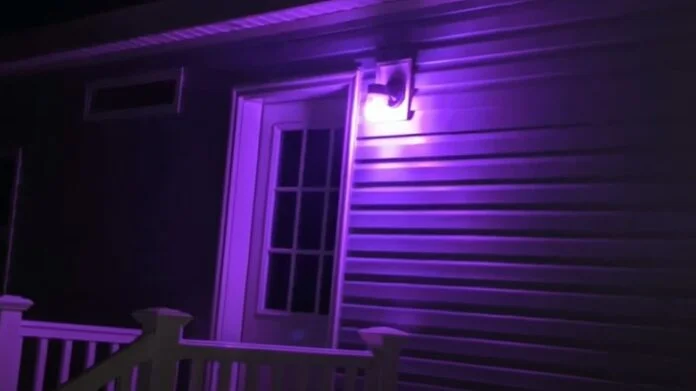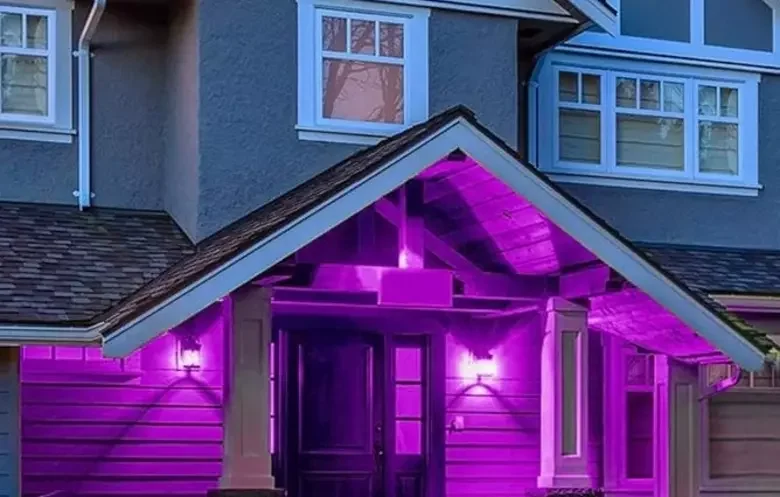Ever driven through a quiet neighborhood at night and noticed a soft purple light glowing from a front porch? It might catch you off guard — it’s not exactly your average porch light. Maybe you think it’s seasonal décor, or someone just likes purple. But that gentle glow? It carries a deeper message than most realize.
Purple porch lights aren’t just for decoration. They’ve become a quiet but bold statement — one of strength, survival, and support.

What the Purple Porch Light Really Stands For
That soft violet hue isn’t random. It’s a symbol of solidarity with survivors of domestic violence. In a world where many suffer behind closed doors and hidden pain, the purple light steps forward as a silent, glowing voice — one that says:
“You are not alone. We see you. You matter.”
There’s no loud announcement, no dramatic banner. Just a single bulb casting a warm, symbolic glow that turns darkness into hope.
Video: What Does The Color Of A Porch Light Mean? (Red, Purple, Blue, Green, Yellow, Orange, Blinking)
Why Purple? The Color of Strength and Survival
Colors carry meaning. Purple, in particular, has long represented dignity, courage, and healing. It’s the official color of Domestic Violence Awareness Month and has appeared in countless campaigns across the globe.
But it’s more than a campaign color. Purple symbolizes the strength it takes to endure abuse, the resilience to move forward, and the bravery to speak up — or simply survive.
So when a porch light turns purple, it becomes more than just a pretty glow. It becomes a beacon. A declaration. A quiet revolution happening one house at a time.
The Hidden Reality of Domestic Violence
Here’s the thing: domestic violence doesn’t look one way. It’s not always bruises or shouting. It can live in silence, in subtle manipulation, in the quiet control of finances, or the constant erosion of self-worth.
It can happen in any home — the apartment down the street, the house next door, or even across your dinner table.
The truth is, many survivors suffer quietly. They may feel ashamed, afraid to speak up, or unsure whether anyone would believe them. That’s what makes the purple light so important. It offers quiet visibility. A sign that says, “You’re not invisible here.”
Where the Movement Began — And Why It’s Growing

The purple light movement began with a grassroots campaign called “Purple Light Nights.” It started small, asking community members to change their porch lights during October to raise awareness. But it didn’t stop there.
It grew.
The glow began to spread — across streets, cities, and countries. People started asking questions. Conversations began. And suddenly, a simple bulb swap became a powerful, community-driven statement.
Today, seeing a purple porch light means you’re looking at a home that supports survivors. A home that says no to silence. A home that believes in change.
Turning Light Into Dialogue: Awareness Through Conversation
That purple light? It sparks curiosity. And curiosity leads to conversation.
What does it mean? Why purple? Who is it for?
These questions open doors — to education, to understanding, and to empathy. They invite neighbors, friends, and even strangers to talk about an issue that thrives in silence.
Every bulb becomes a teaching moment. A reminder that awareness begins not with statistics, but with storytelling, listening, and human connection.
What You Can Do Beyond Changing a Bulb
Video: Why are America’s streetlights turning PURPLE?
Changing a porch light to purple is a beautiful start. But there are more ways to turn awareness into action:
Educate Yourself and Others
Learn the signs of abuse. Understand the emotional, financial, and psychological tactics that don’t always leave bruises. Share what you learn. Knowledge can protect — and empower.
Support Local Shelters and Hotlines
Many crisis centers are underfunded and overwhelmed. Donations, volunteer time, or simply sharing resources can make a major impact. Consider reaching out to your local shelter or contributing to the National Domestic Violence Hotline: 1-800-799-SAFE (7233).
Listen With Compassion
If someone opens up to you, listen — without judgment or pressure. Survivors need to feel safe, believed, and respected. Your support could be a turning point in their journey.
Speak Out When It Matters
Disrupt patterns of abuse, even in conversation. If you hear someone making jokes or excuses for controlling or harmful behavior, call it out. Social silence keeps abuse alive. Your voice can help stop it.
Promoting Prevention Through Everyday Acts
Support is vital, but preventing domestic violence from happening in the first place is just as important. We can all play a role in prevention:
- Teach young people about healthy boundaries and relationships.
- Encourage emotional openness and communication in families.
- Challenge harmful gender roles and power dynamics.
- Promote accountability, not excuses, for abusive behavior.
These aren’t big, flashy acts. They’re daily choices — and they matter more than we know.
What to Think When You See a Purple Porch Light

Next time you spot that soft glow, take a moment.
You might be looking at a survivor’s home — someone quietly healing from a painful past. Or maybe it’s a house where someone helped a loved one escape. Or it could be someone who just cares deeply about the cause.
Either way, that light is shining with intention.
It’s not about perfection or performance. It’s about presence. It’s about telling the world, “We’re here. We care. And we won’t stay silent.”
Conclusion: Shine a Light, Start a Change
Domestic violence hides best in silence — but a purple light says otherwise.
It says that hope exists. That strength takes many forms. That healing isn’t a solo journey.
Whether you’ve experienced abuse, supported someone through it, or simply want to make a difference in your community, there’s something you can do. Even if it starts with just a lightbulb.
So if this message speaks to you — light it up.
Glow purple. Spark conversations. Share resources. Create space for healing.
Because sometimes, the smallest light makes the biggest difference in someone’s darkest night


